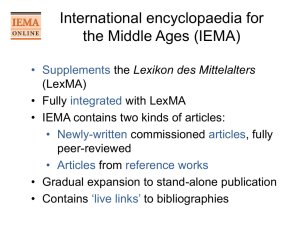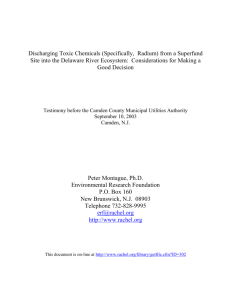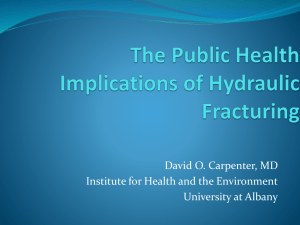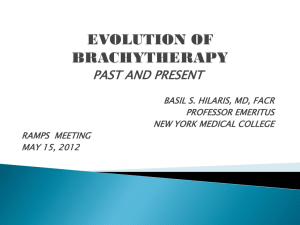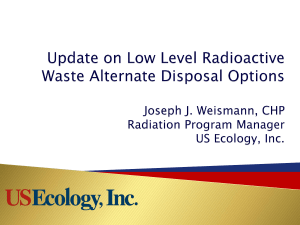Overview and Implementation of Radium Treatment Residual
advertisement
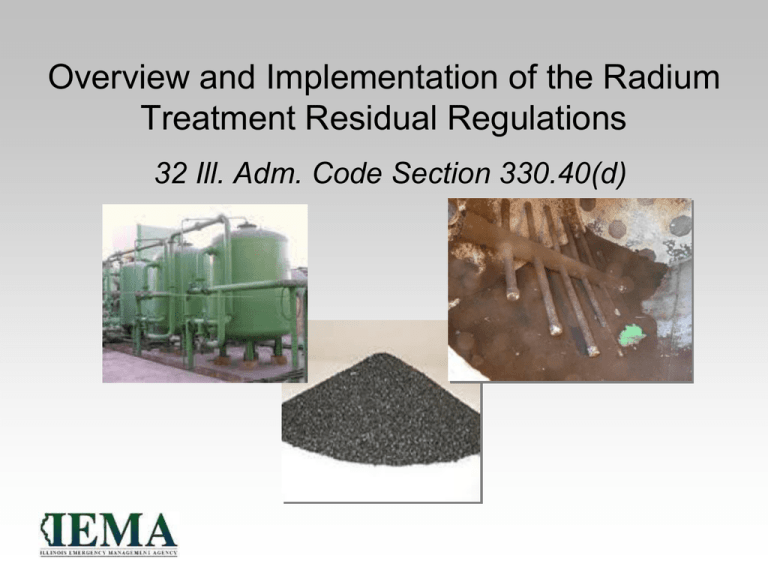
Overview and Implementation of the Radium Treatment Residual Regulations 32 Ill. Adm. Code Section 330.40(d) Background and Involvement – Illinois Environmental Protection Agency (IEPA) • Drinking Water Compliance Section (Radionuclide Rule) • Water Pollution Control NPDES & Wastewater Compliance – Illinois Emergency Management Agency (IEMA) • Environmental Monitoring: Radioactivity in the environment and around nuclear facilities • Verification and Oversight for Decontamination and Decommissioning projects • Performs site surveys and sampling for license termination • Inspect/Escort certain classes of Radioactive Materials Shipments • Respond / Investigate radiation alarms or allegations • December 2010, Low Level Radioactive Waste Section to implement Section 330.40(d) Topics of Discussion • How 32 IL Admin Code Section 330.40(d) came about. • What the Regulations Seeks To Do. • Specific Provisions and Requirements. • What is the Scope of Regulated Persons? • How is This Being Implemented? • Question / Answer How Section 330.40(d) Came About: • 1984 MOA between Illinois EPA and IEMA – 0.1 pCi/g increase above background for land application sites. – Implemented and monitored by Illinois EPA • 2003 Radionuclide Drinking Water Standards – Treatment installations/technologies increased – Radium concentrations in residuals increased • Municipalities encroached upon 0.1 pCi/g increase in soil as a result of land application. How Section 330.40(d) Came About (continued): • Illinois Pollution Control Board Ruled the MOA an “Unpromulgated Regulation” – IEMA evaluated an increase to a 0.4 pCi/g Limit – Opposition to the proposed rule Increased • February 28, 2011 - 32 Ill. Adm. Code 330.40(d) – Provided Exemption from Licensure – Implemented by IEMA – Limits the Amount of Radium Land Applied to 1.0 pCi/g increase – Specifies Avenues for Proper Disposal – Drinking water AND Wastewater Facilities What exactly does the new rule do? • Prior to this exemption, there were no exempt concentrations or quantities for radium • Therefore – all radium concentrated from the treatment of water or sewage was subject to the licensing requirements of IEMA-DNS • The Rulemaking is an exemption. • Provides specific criteria for the disposal of treatment residuals containing radium less than or equal to 200 pCi/g and/or land application of treatment residuals containing radium less than or equal to 100 pCi/g. 6 What does the rulemaking do? (continued) • Creates an awareness among Drinking Water Treatment Facilities – Radium residuals are often far more problematic • Tracks Radium Land Applications in a manner similar to Part 391 Metals’ Loadings and Ceiling Limits: – – – – – 1.0 pCi/g increase in background radium concentrations 3.0 pCi/g ceiling limit Up to 100 pCi/g biosolids can be land applied Up to 200 pCi/g residuals can be landfilled Monitoring and Reporting to Ensure Limits are Met and Maintained Specific Rule Requirements • Description of each requirement as listed in Section 330.40(d). • Short Discussion on the Types of Facilities to which they would apply. • Logic and process in which IEMA is implementing each requirement. Specific Rule Requirements • Registration with IEMA – Owners and operators of plants producing residuals or sludge from the treatment of water or sewage and containing radium occurring naturally from groundwater. – Owners and operators of IEPA permitted landfills receiving residuals and/or sludge containing radium – Applicators who apply these residuals and sludge to agricultural lands – Other (as determined by IEMA) 9 Specific Rule Requirements • Registration (continued) – Online Response: www.state.il.us/iema – Verify Contact Information – Verify Treatment – Verify Facilities to Which a Waste Stream is Sent / Received. – Notifies Regulated Persons about the Rule Specific Rule Requirements (continued) • Landfill Disposal – Residuals / Sludge Containing Radium with Concentrations ≤ 100 pCi/g: – Covered During Transport – Packaged or Stabilized if Easily Dispersible – Cover of 10 ft of Non-Contaminated Overburden (at time of landfill closure) – Applies to Drinking Water Treatment Media – Applies to Wastewater and Drinking Water sludges or biosolids produced. Specific Rule Requirements (continued) • Land Application – Residuals / Sludge Containing Radium with Concentrations ≤ 100 pCi/g: – Cumulative Increase in Soil Radium Concentration Limited to 1.0 pCi/g – Limit Applies to the Sum of all Land Applications from all Applicators – Ceiling Soil Radium Concentration Set at 3.0 pCi/g (background of 2.2 affords a 0.8 pCi/g increase) Specific Rule Requirements (continued) • Land Application (continued) – Land Application in Accordance with Illinois EPA Sludge Regulations – Concentration of Treatment Residuals must be Determined by Laboratory Analysis – Baseline Radium Concentration must be Determined prior to application. i.e. “Field Sampling” Specific Rule Requirements (continued) • Land Application (continued) – Concentration of Treatment Residuals must be Determined by Laboratory Analysis • Some Illinois NPDES or Land Application Permits have Radium Sampling Requirements. NOT ALL DO. • If Mailed a Registration Requirement by IEMA – Land Applying your Residuals will Require a Representative Sample. • Frequency? Specified in your Illinois EPA Permit or Determined by the Generator. Specific Rule Requirements (continued) • Land Application (continued) – Baseline Radium Concentration must be Determined. i.e. “Field Sampling” prior to use: • Sampled by June 1, 2011 for fields land applied in Spring of 2011. • If Not Already Sampled, Sample Prior to Next Land Application. • Sampling to Determine the Baseline Radium Concentration is Performed Once. Specific Rule Requirements (continued) • Land Application (continued) – Baseline Radium Concentration must be Determined. i.e. “Field Sampling” prior to use: • 12 inch depth • 1 composite sample per 8 acres (391.510a), or • Sampling in Accordance with the Illinois Agronomy Handbook – “Zones of Common Characteristics” – One composite sample per continuous, singleownership field. Specific Rule Requirements (continued) • Land Application (continued) – Landowner (or authorized agent) must acknowledge the he/she is aware that residuals or sludge containing radium is being applied to their land • Form Updated as ownership changes • Form developed by IEMA with Stakeholder Input. • Available in the Guidance Document. • May be Incorporated into Existing Documentation. – Concerted Education is Imperative. Specific Rule Requirements (continued) • Field Requirements for Land Application – pH of 6.0 – Within top 5 feet and above bedrock and groundwater: • 6” layer with clay content of at least 18% (county soil survey book) • 6” layer with organic content of at least 12 tons per acre (site specific testing) – Tobacco may not be cultivated on fields land applied with radium residuals. Specific Rule Requirements (continued) • Field Requirements for Land Application (continued) – When the Increase in Soil Radium Concentration is Calculated to be 0.8 pCi/g or when the Site’s Soil Radium Concentration is Calculated to be 2.8 pCi/g: • Discontinue use of field, or Land Apply Biosolids Sourced from a Generator Not Regulated by Section 330.40(d) • OR Repeat Soil Sampling and Radium Analysis – If less than 3.0 pCi/g total radium, then continue use of field – If equal to or greater than 3.0 pCi/g, discontinue use of field – “Zones of Common Characteristics” whole field compositing NOT Allowed. 19 Specific Rule Requirements (continued) • Field Requirements for Land Application (continued) – Calculating Radium Accumulation • Soil Density of 90lbs/cubic foot • Mixing Depth of 12” • A 1.0 pCi/g increase equates to 1778 micro Curies per acre. • For each load of sludge / biosolids taken to a field (from any generator, by any applicator) – the total number of picoCuries applied are averaged over the entire number of acres. Specific Rule Requirements (continued) • Field Requirements for Land Application (continued) – Reporting Field Data • Can be Done in an Annual Report or Prior • Online Reporting Mechanism In Development • Section, Township, Range, a central GPS point in the field, and the Number of Acres. • The Baseline Radium Sample Result. • Signed Landowner Acknowledgement Form. • pH, OM, and Clay Content Data – Certification Only • Draft Form is Available Upon Request • Final Forms will be mailed in January Specific Rule Requirements (continued) • Annual reporting requirements – Landfill • Quantity, Sample Result or IEMA Certification Residual was Beneath 200 pCi/g, Date of Disposal, Landfill Name/Location – Land application • Location, Background Radium Concentration (first use of field), Sludge Analytical Result, Application Rate, Date of Application – Online or Mailed in. Similar to Format to IEPA Semiannual Sludge Report. Specific Rule Requirements (continued) • For residuals/sludge containing > 100 and ≤ 200 pCi/g: – Method of disposal must be reviewed and approved in advance by IEMA • Landfill disposal is the likely disposition • Notifies IEMA of possible worker exposure issues and affords an opportunity to assess. – Disposal in a licensed LLRW disposal facility is another option Who is Regulated under Section 330.40(d)? • Drinking Water Treatment Facilities – 1. Treatment Technology – 2. Treatment Technology AND Aquifer • Wastewater Treatment Facilities – Only Those Receiving a Treatment Process Waste Stream from a Drinking Water Treatment Facility Identified in the Second Category Above. • Land Applicators – Anyone who takes the residuals from the generator – Includes private contractors, golf courses, etc. – Protects the liability of the generator and land owner Who is Regulated under Section 330.40(d)? • Following the Radium Starts at the Drinking Water Treatment Facility. • Not just MCLs or Radium Treatment • Groundwater Treatment Only. • Define the Treatment Technology • Define the Aquifers Drinking Water Treatment Media can far Exceed Wastewater Sludge Concentrations Drinking Water Treatment Media • Responses include facilities NOT treating for radium • Include Southern Illinois Communities • Facilities treating for radium have been working with IEMA to avoid creating residuals in excess of 200 pCi/g • Many Drinking Water Facilities are not aware of Radium Accumulation until Refused for Disposal • Radium Removal Systems Pose the Largest Disposal Problems in Backwash Holding Tanks Drinking Water Treatment Media (continued) • Even low levels of radium can be concentrated over time. • Therefore, treatment is the first criteria for inclusion in regulatory scheme. – – – – – – Ion Exchange Lime Softening Anthracite or Activated Carbon HMO Greensand or Sand Filtration Reverse Osmosis • List Continually Refined and Residuals Sampled. Drinking Water Treatment Media (continued) • If a Drinking Water Treatment Facility utilizes one of these treatment technologies, the media itself must be monitored prior to disposal. (the sand, gravel bed, filter, resins, etc.) • Screening is acceptable for landfill disposal. • These residuals not typically land applied. – Lime Softening Exemption • If the aquifer from which the facility draws source water is not identified by the USGS as having elevated radium concentrations from surrounding bedrock, – No Wastewater Treatment Plant Registration – No Land Application Requirements on the Sludges. Drinking Water Treatment Facilities • If the aquifer from which the facility draws source water is identified by the USGS as having elevated radium concentrations from surrounding bedrock... – Any wastewater treatment facility receiving a waste stream is a registrant as well. – Any land applications or landfill disposals are regulated under Section 330.40(d). – Field Sampling and Tracking Radium Accumulation for Drinking Water and Wastewater Sludges Aquifers Designated by IEMA • • • • Devonian Silurian Cambrian Ordovician • Typically deep wells in Northern Illinois. • However, also any aquifer that yields an MCL. Who is Regulated under Section 330.40(d)? • 1186 Drinking Water Facilities Utilizing a Groundwater Source • “Treatment” Defined – Resulted in 482 Community Water Supplies required to register. – These must all report and sample the MEDIA prior to disposal. • Of the 482 Drinking Water Treatment Facilities, 182 draw Water from a Radium-Contributing Aquifer. – These must follow land application requirements. – Wastewater Treatment Facilities Receiving a Waste Stream Flow must Register and Meet all Land Application / Landfill Disposal Requirements. Wastewater Treatment Facilities • • • Approximately 980 in state. Only subject to Section 330.40(d) Regulation if Receiving a Waste Stream from a Drinking Water Treatment Facility that is: 1. Employing a Treatment Technology Capable of Concentrating Radium. 2. Drawing Source Water from an Aquifer Identified to Contribute Elevated Radium Concentrations 147 Wastewater Treatment Facilities Currently Meet this Criteria. Who is Regulated under Section 330.40(d)? • Land Applicators – If persons utilize sludge or biosolids that are required to be tracked according to Section 330.40(D) then they too must comply with the provisions of Section 330.40(d). – Individual Contractors – Itemized in the Annual Report of Sludge Disposition. Lacking a Regulatory “Box” • Working with Individual Systems • “CCA” Approach • Case Specific Exemptions – Sludges Beneath 3 pCi/g – Land Application (and Lime) from Drinking Water Facilities using ‘Treatment Only’ • Unique Circumstances by Design – Golf Course Irrigation – No Discharge – Dilution From Surface Water Flow • Goal is to Narrow Scope: Data Needed. Additional Information • www.state.il.us/IEMA – Download a Copy of the Regulations – Download the Guidance Document – View Listings of Required Registrants • Drinking Water Facilities - Treatment ONLY • Drinking Water Facilities - Treatment AND Aquifer • Wastewater Facilities (Flow from Treatment & Aquifer Drinking Water Facilities) Additional Information • Workshops, presentations or questions, contact: Gary Forsee IEMA, LLRW 1035 Outer Park Dr Springfield, IL 62704 (217) 782 1326 Gary.Forsee@illinois.gov
